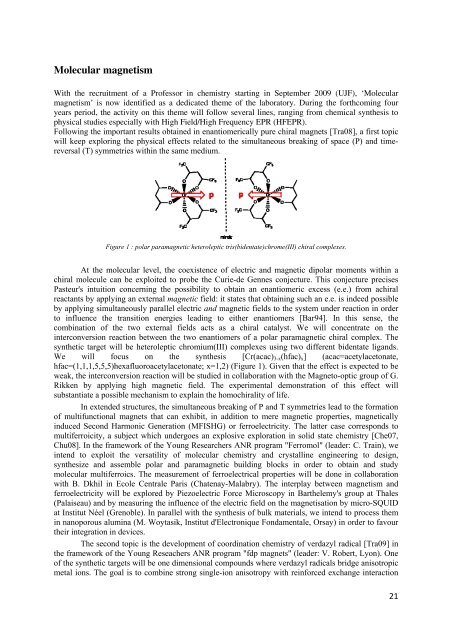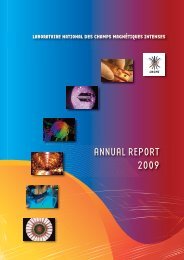Laboratoire National des Champs Magnétiques Pulsés CNRS – INSA
Laboratoire National des Champs Magnétiques Pulsés CNRS – INSA
Laboratoire National des Champs Magnétiques Pulsés CNRS – INSA
Create successful ePaper yourself
Turn your PDF publications into a flip-book with our unique Google optimized e-Paper software.
Molecular magnetism<br />
With the recruitment of a Professor in chemistry starting in September 2009 (UJF), ‘Molecular<br />
magnetism’ is now identified as a dedicated theme of the laboratory. During the forthcoming four<br />
years period, the activity on this theme will follow several lines, ranging from chemical synthesis to<br />
physical studies especially with High Field/High Frequency EPR (HFEPR).<br />
Following the important results obtained in enantiomerically pure chiral magnets [Tra08], a first topic<br />
will keep exploring the physical effects related to the simultaneous breaking of space (P) and timereversal<br />
(T) symmetries within the same medium.<br />
Figure 1 : polar paramagnetic heteroleptic tris(bidentate)chrome(III) chiral complexes.<br />
At the molecular level, the coexistence of electric and magnetic dipolar moments within a<br />
chiral molecule can be exploited to probe the Curie-de Gennes conjecture. This conjecture precises<br />
Pasteur's intuition concerning the possibility to obtain an enantiomeric excess (e.e.) from achiral<br />
reactants by applying an external magnetic field: it states that obtaining such an e.e. is indeed possible<br />
by applying simultaneously parallel electric and magnetic fields to the system under reaction in order<br />
to influence the transition energies leading to either enantiomers [Bar94]. In this sense, the<br />
combination of the two external fields acts as a chiral catalyst. We will concentrate on the<br />
interconversion reaction between the two enantiomers of a polar paramagnetic chiral complex. The<br />
synthetic target will be heteroleptic chromium(III) complexes using two different bidentate ligands.<br />
We will focus on the synthesis [Cr(acac)3-x(hfac)x] (acac=acetylacetonate,<br />
hfac=(1,1,1,5,5,5)hexafluoroacetylacetonate; x=1,2) (Figure 1). Given that the effect is expected to be<br />
weak, the interconversion reaction will be studied in collaboration with the Magneto-optic group of G.<br />
Rikken by applying high magnetic field. The experimental demonstration of this effect will<br />
substantiate a possible mechanism to explain the homochirality of life.<br />
In extended structures, the simultaneous breaking of P and T symmetries lead to the formation<br />
of multifunctional magnets that can exhibit, in addition to mere magnetic properties, magnetically<br />
induced Second Harmonic Generation (MFISHG) or ferroelectricity. The latter case corresponds to<br />
multiferroicity, a subject which undergoes an explosive exploration in solid state chemistry [Che07,<br />
Chu08]. In the framework of the Young Researchers ANR program "Ferromol" (leader: C. Train), we<br />
intend to exploit the versatility of molecular chemistry and crystalline engineering to <strong>des</strong>ign,<br />
synthesize and assemble polar and paramagnetic building blocks in order to obtain and study<br />
molecular multiferroics. The measurement of ferroelectrical properties will be done in collaboration<br />
with B. Dkhil in Ecole Centrale Paris (Chatenay-Malabry). The interplay between magnetism and<br />
ferroelectricity will be explored by Piezoelectric Force Microscopy in Barthelemy's group at Thales<br />
(Palaiseau) and by measuring the influence of the electric field on the magnetisation by micro-SQUID<br />
at Institut Néel (Grenoble). In parallel with the synthesis of bulk materials, we intend to process them<br />
in nanoporous alumina (M. Woytasik, Institut d'Electronique Fondamentale, Orsay) in order to favour<br />
their integration in devices.<br />
The second topic is the development of coordination chemistry of verdazyl radical [Tra09] in<br />
the framework of the Young Reseachers ANR program "fdp magnets" (leader: V. Robert, Lyon). One<br />
of the synthetic targets will be one dimensional compounds where verdazyl radicals bridge anisotropic<br />
metal ions. The goal is to combine strong single-ion anisotropy with reinforced exchange interaction<br />
21







